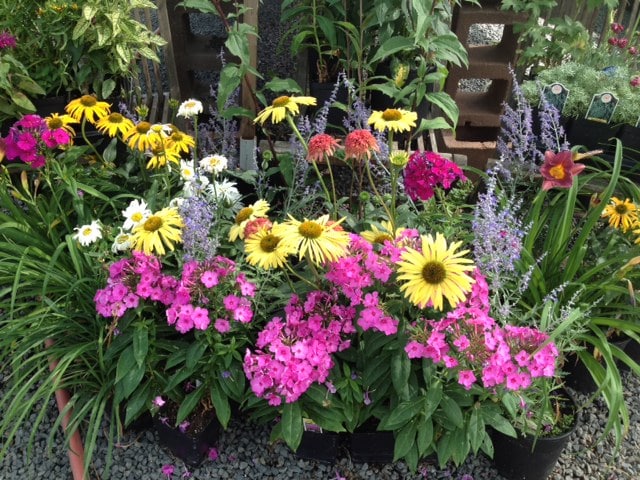Site Selection – choose your garden location before designing it.
Site selection is the first step in planning a successful perennial garden. Evaluate the location for sun and shade, wind, soil type and irrigation options. Also consider ease of access, proximity to outdoor living areas, and visibility.
Locate the perennial garden so that if possible, it can be accessed from two sides. This makes it easier to maintain. Most perennials require abundant sunshine – approximately 10 hours of sunlight during the longest days of summer. Shade-loving perennials such as hostas, heucheras and ferns may be grown in less sunlight or filtered shade.
Garden Design – plan the area to scale on paper.
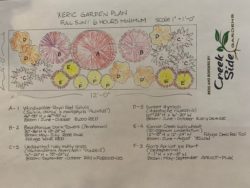 Perennial plants can live many years, so careful planning is required. Determine garden size by available space and the amount of time you have for maintenance. Perennial gardens should be simple to maintain, accessible, and supply a progression of flower colors and textures all season.
Perennial plants can live many years, so careful planning is required. Determine garden size by available space and the amount of time you have for maintenance. Perennial gardens should be simple to maintain, accessible, and supply a progression of flower colors and textures all season.
To begin the design, measure the proposed site. On graph paper, sketch the layout to scale. Locate existing structures, walls, fences, walks etc. Locate existing plants such as trees and shrubs. Sketch the desired outline of the garden.
After deciding on the space, follow these basic design principles:
- Place plants of the same variety in groups of three, five or seven (odd numbers) to increase the effect of color and texture.
- Repeat groups of the same plant type two or three times throughout the space, to give it continuity and create harmony.
- Use tall plants at the back of a two-sided garden or in the middle of an island bed.
- Complement tall plants by gradually placing shorter plants towards the outer perimeter, ending with low border plants at the edge of the bed. This gives a smooth transition from tall heights down to the border plants.
- Use various colors, textures and forms to add interest to the garden. Consider using more plants of fewer varieties for a simpler, more pleasing effect. However, don’t overuse one type of perennial.
- Consider bloom time and foliage (color and texture) to create a succession of interest throughout the seasons.
- Complement perennials with annuals and bulbs for bright focal points and accents during low bloom periods.
- Leave room for plant growth and allow for individual plant growth habits. In general, plant tall perennials 18 to 36 inches apart, intermediates 12 to 18 inches apart, and dwarfs 6 to 12 inches apart.
- Don’t place plants in straight rows — use a scattered or triangular spacing so one mass blends into another.
Plant Selection – prepare a list of desired perennials.
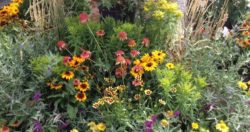 A well-designed perennial garden can provide many years of beauty and enjoyment. Careful selection of plant materials and thoughtful planning can result in a full season of color. The list of possible perennial plants is long.
A well-designed perennial garden can provide many years of beauty and enjoyment. Careful selection of plant materials and thoughtful planning can result in a full season of color. The list of possible perennial plants is long.
Choose plants for flower color, bloom period, height and light requirements. Compile a chart, organizing this information in an easily viewed manner. Bloom times may vary with weather, soil conditions and elevation. At higher elevations, bloom times are later.
The most important consideration in selecting plants for a perennial garden is to group them according to their environmental and cultural requirements. For example, place drought-tolerant plants together at the top of a slope and moisture-loving plants in a swale or low spot where runoff collects. This is called hydrozoning.
Other plant characteristics to consider for easier maintenance include: cold hardiness, heat tolerance, insect and disease resistance, cultural requirements (staking, pruning, fertilizing, deadheading, frequent division), and invasiveness.
Site and Soil Preparation – add organic matter to improve aeration and drainage.
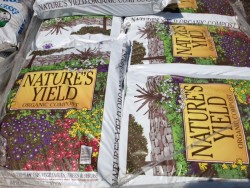 Prepare the site by removing any existing grass or other plant material in the designated bed. Install edging to prevent encroachment of lawn grasses. This also gives the bed form.
Prepare the site by removing any existing grass or other plant material in the designated bed. Install edging to prevent encroachment of lawn grasses. This also gives the bed form.
Next, incorporate organic matter. A general recommendation is the equivalent of a 1-2 inch layer of compost, peat moss or aged manure to a depth of 8-12” deep.
Planting – perennials grown in containers may be planted any time during the growing season.
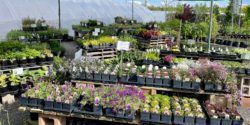 Inspect plants prior to purchase. Look for plants whose new roots are fleshy and creamy white, and whose stems are not leggy. Remove the container before planting. If the soil ball is entangled with masses of roots around the outer edge, carefully make shallow cuts (1/2 inch or less) in several places along the outside of the root ball to encourage roots to grow out into the surrounding soil.
Inspect plants prior to purchase. Look for plants whose new roots are fleshy and creamy white, and whose stems are not leggy. Remove the container before planting. If the soil ball is entangled with masses of roots around the outer edge, carefully make shallow cuts (1/2 inch or less) in several places along the outside of the root ball to encourage roots to grow out into the surrounding soil.
To minimize root drying, don’t remove plants from their containers until just before planting. Store plants in a cool, shady area until planting time. Place them at the same soil level as they were in the container. Avoid deep planting because plant roots often suffocate when planted too deeply. Once plants have been placed in the hole, backfill around the soil ball. Water well.
Culture and Maintenance – perennials often require less maintenance than most annual flowers.
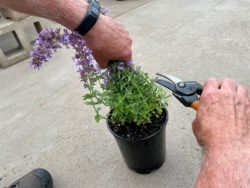 Watering frequency varies with sun and wind exposure, temperature, soil type and individual plant water needs. Drooping leaves or stems and blossom drop often are signs that irrigation needs to be increased. New plantings in full sun often need water every two days the first few weeks or so after planting, depending on weather conditions. Progress to longer intervals between watering (four to six days) to encourage roots to expand into surrounding soil. Mulched plants will not dry out as quickly. Adjust watering frequency accordingly.
Watering frequency varies with sun and wind exposure, temperature, soil type and individual plant water needs. Drooping leaves or stems and blossom drop often are signs that irrigation needs to be increased. New plantings in full sun often need water every two days the first few weeks or so after planting, depending on weather conditions. Progress to longer intervals between watering (four to six days) to encourage roots to expand into surrounding soil. Mulched plants will not dry out as quickly. Adjust watering frequency accordingly.
Maintenance during the growing season consists of periodic weeding, removal of spent blossoms (deadheading), staking if necessary and pest control. Depending on species, early spring or fall maintenance consists of trimming and removing old leaves and stems. Ornamental grasses are generally trimmed in early spring. After three to five growing seasons, some perennials may need to be divided to prevent overcrowding. Overcrowded perennials often bloom poorly or not at all.
Mulching is one way to reduce weed growth and conserve water. Watering during the winter is very important, depending on weather conditions. Colorado winters characteristically have dry air and low soil moisture. These conditions, along with little or no snow cover from October through February, can damage plants, especially new plantings. Water only when temperatures are above freezing, during the early part of the day. Some perennials prefer well drained dryer soil in winter to survive.

